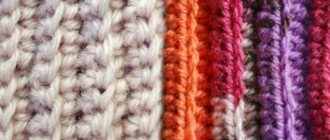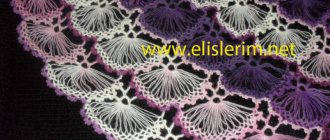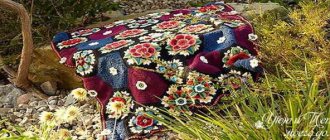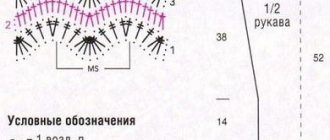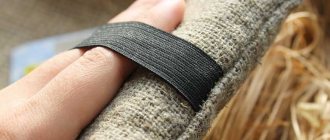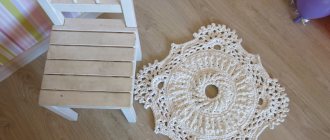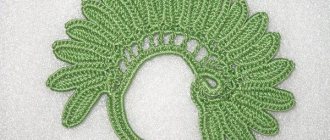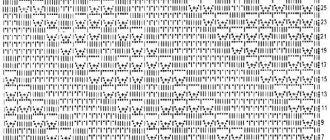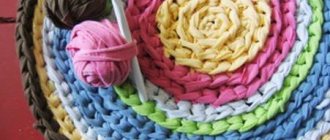Needlework
06/07/2018 Anastasia Prozheva
Nowadays, handmade work is wildly popular and in great demand. It is valued for its unique airy images, originality and lightness of openwork compositions. It is precisely these qualities that continuous crocheting of motifs is famous for, a detailed description of which is proposed in this article.
Let's understand the basics
Everything is elementary. Products made using crochet are exclusive; something similar is difficult to create using any other method.
These days there are a lot of knitting techniques: from the simplest to the incredibly complex. When looking at things produced using this technology, one might think that the fabric was knitted from individual elements, which were subsequently fastened together. But the name of the method alone suggests the opposite; during knitting, the thread is continuous and creates a wonderful motif in a long chain.
There are a lot of beautiful products made using crocheted motifs. But it can be uninteresting and tedious to knit the endless monotony of motifs, then hide the thread and fasten them into a single whole. And if the item is not in season or “does not fit the figure,” then there is no point in unraveling and tying it up.
Here are just some knitting patterns without tearing the thread; using them, it is possible to knit such things as a scarf, handbag, blouse, skirt and much more:
Combination of individual motifs
Getting the individual motifs together correctly is just as important as tying them together, because the appearance of the finished product will depend on it. Most often, finished motifs are sewn with a needle behind the back walls of the loops to create a flat seam. The method of crocheting motifs is also popular.
Every knitter has her favorite motifs. With the help of motifs, you can not only create original and beautiful things, but also add unusual elements to familiar products. The ability to use and harmoniously combine different patterns of motifs is an indicator of the skill of the needlewoman, the very “clothes” by which they are usually greeted.
https://youtu.be/6vSvHTsTzFIhttps://youtu.be/EG594fA4lKI
_
Square motifs
A master class on crocheting motifs will be very useful for entry-level needlewomen.
Knitting square motifs is a very interesting technology. The unpretentious method of knitting square motifs is certainly universal; craftswomen usually use this technique to create tablecloths, openwork napkins or shawls.
You will need:
- Cotton yarn 50g/1175 m;
- Hook No. 2.5.
Work steps:
- Dial 15VP.
- First row: 3VP, 2VP, 1 double crochet in the third stitch of the same level.
- Second row: knit in the same way in the opposite direction.
- Third row: performed identically to the second, but in the opposite direction.
- Fourth row: like the third, but in the opposite direction.
- Fifth row: identical to the fourth, only in the opposite direction.
- Sixth row: tying around the perimeter of a small square - 3WPP, 4DC, bridging the corner column, then 3 double crochets in the jumpers. In the corners - 9СН.
- Seventh row: do it according to the diagrams, in the corners 10СБН, then 9VP.
- Eighth row: from the corner 3VP, then into the jumper from 9VP of the previous row 11 stitches with 2 crochets and between them 1VP.
- Ninth row: into the jumper from 3VP of the previous level, knit 4SC, then chains of 3VP into each small jumper from 1VP between the double crochets of the previous row. There are 11 chains in total. Connecting squares is easiest done by focusing on the last row of each level.
Related article: How to make masks with your own hands: paper templates with diagrams
- As before, square motifs are performed according to the same pattern.
Watch a video tutorial on how to crochet square motifs:
Continuous Crochet Patterns
View > Home / Knitting for women, Master class, Openwork knitting
30 Oct 2021 Category: Knitting for women, Master class, Openwork knitting
your feedback
As you know, there are simply an incredible number of crochet techniques, so each craftswoman chooses for herself exactly the option that suits her best for each specific knitting. In particular, those who have thoroughly mastered knitting motifs (round, square, triangular, openwork, etc.) have the right to choose - knit them separately (collect the required number of individual elements) or make a crocheted fabric in a permanent way.
Of course, knitting individual motifs is easier than creating a continuous fabric with their help, however, the latter has an important advantage - the knitter does not need to worry about a huge number of “tail” threads, which always have to be skillfully hidden inside the knitting.
Today we invite you to take a closer look at continuous knitting, which allows you to create light openwork items from gradually knitted motifs. True, if we talk about finished products, even an experienced craftswoman will not always be able to distinguish whether it is knitted from individual motifs or as a whole cloth. But the name of the technique speaks for itself: during the knitting process, the thread does not need to be broken, and the pattern is formed thanks to a special method of knitting motifs.
It consists of the following:
- the first motif is not knitted to the end (i.e. the last row of the motif is not knitted/knitted completely);
- the transition to knitting the second motif is carried out without breaking the thread; for this it is necessary to knit a chain from the VP and start knitting a new motif;
- in the knitting process, the second motif must be attached to the first, and its last. the row, just like the first motif, is not knitted to the end, suggesting knitting of the third motif;
- This generally established sequence of actions fits any continuous knitting pattern.
For those who don’t like constantly looking for a convenient “place” to hide the thread, continuous knitting is perfect. Moreover, this technique has another important advantage: if suddenly while knitting the needlewoman doubts the correctness of her actions, the product can be unraveled at any time and knitted in a new way, thereby maintaining the functionality of the thread.
For beginners in crocheting, we recommend starting to master the continuous technique by knitting motifs and simple products (shawls, scarves, tops).
We will try to introduce beginner knitters to the basic principles of working without breaking the thread - we bring to your attention several detailed master classes on knitting motifs without breaking the thread.
Abbreviations in the text:
- VP – air. a loop;
- Runway - air. lifting loop;
- CCH or art. s/n – double crochet;
- RLS or art. b/n – single crochet;
- PSSN – half double crochet;
- pet. - a loop;
- flail - chain;
- mot. – motive;
- PR – previous row;
- СС – connecting column.
Step-by-step execution of a simple continuous canvas of floral motifs
Knitting pattern:
We knit the 1st floral pattern, we knit 5 arches from VP, indicated in the diagram in red.
We knit a chain. from 13 VPs (indicated in purple).
Afterbirth. pet. You can mark it with a marker or just hold it with your finger, dial 5 more VPs, close them in a ring in the 13th air. loop.
We knit according to the pattern of the 2nd motif until it is combined with the 1st motif.
We connect to the air arch. loops PR of the first mot., we knit an arch for 5 VP, we knit 6 more arches from VP.
We repeat the previous steps from points 1-5 as many times as necessary.
Continuous knitting of dense floral motifs
Floral motifs, knitted in a permanent way, make magnificent models of women's clothing: a variety of blouses, dresses and tunics. If single motifs are no longer a difficulty for you, try practicing the continuous technique, we guarantee that you will not remain indifferent to this knitting.
We begin knitting by knitting the first floral motif into 8 petals in a edging of columns.
Knitting pattern and connecting motifs:
Last row - we knit only half of the binding, there is no need to knit the second yet, we immediately move on to the 2nd mot. We decide on the number of VPs for the transition, recruit according to the scheme - we have 12 VPs.
Next, we collect 5 more VPs as the basis of the 2nd mot., We close them in a ring. By chain lift up 3 sts using half-columns.
We knit the 1st round. Row according to the diagram. We close it with a chain. and raise 4 stitches for knitting the 2nd row.
We knit the 2nd round. row according to the diagram, raise another 3 stitches along the chain, go to the 3rd row.
When moving to the 4th row, do not forget to connect the 2nd mot. with the 1st motive at the points of their contact.
Last row of the 2nd mot. you need to knit either ½ (if you knit motifs lengthwise) or ¾ (if the motif is the last in the row, but you need to switch to knitting the next (upper) row of motifs).
We suggest moving to the second row to work the knitting trail. stage of continuous technology.
Again we knit 12 VPs coming from the 2nd motive, as well as 5 VPs for the base of the 3rd motive. We close these 5 VPs in a circle. We knit a circular motif according to the pattern.
Afterbirth. circle. We knit the row again either ½ or ¾, depending on the nature of the subsequent knitting. When the last motif is tied, we tie it completely, smoothly move on to tying the parts of the motifs that remain untied, and at the same time do not forget to connect them to each other at the points of contact. As a result, we get a solid canvas of motifs knitted without tearing off the thread. Thanks to this method, you can knit fabric of any desired length and width.
Complex knitting of continuous fabric in the “royal square” style
The Royal Square is ideal for creating exclusive items of women's wardrobe - it looks chic in blouses, tunics, thin blouses and elegant dresses.
The technique of knitting it is quite complex; not every craftswoman will take up knitting such a motif. However, it’s definitely worth the risk; the results will exceed all your expectations!
Knitting pattern for a square motif:
Progress:
Row No. 1. We collect 12 VP, close it in a ring using SS. We cast on 5 more VPs, skip 2 stitches, and knit 1 stitch into the 3rd stitch. s/n + raise 5 VP again.
In the same 3rd stitch of the warp we knit another 1 tbsp. s/n and dial 2 VP.
Again we skip 2 p., in the 3rd we knit a st. s/n + 5 VP.
In the same loop we knit 1 tbsp. s/n + 2 VP. We skip 2 p., knit “st. s/n + 5 VP + st. s/n" in the next p. and 1 tbsp. s/n to the beginning of the row. We collect 2 VP.
Let's knit the last one. Art. s/n in the 3rd runway. We collect 1 VP. At this stage, a square as the basis of the motif should emerge.
Row No. 2. Visually, the square is divided into 9 cells. In the 1st cell - knit 4 tbsp. b/n, in the second - 2 tbsp. b/n, from the second article. - let's pick up the flail. out of 10 VPs.
We work a SS to the top of the column. For convenience, turn the work over to the wrong side, cast on 1 VP and return it to the front side. We knit 2 tbsp into the resulting ring. b/n, 3 VP (chain loops will become open picot).
2 more tbsp. b/n at the base of the chain. + 3 VP (pico).
3 more rubles we knit a rapport: “2 tbsp. b/n + 3 VP", then 2 tbsp. b/n, in total there should be 5 picots. We knit another 1 tbsp into the same square. b/n, next corner square - knit only st. b/n. Next knit the cage 2 tbsp. b/n and collect the flail. for 10 VP for the same ring. We carry out all the steps for knitting 5 picots by analogy. Using this principle, we tie all the cells of the square.
In the 1st square we add 3 tbsp. b/n, close the row SS at the top of the 1st st. b/n. 1 runway.
Row No. 3. To the top of the last. Art. b/n PR – 1 tbsp. b/n, 7 VP. SS in 2nd picot. 8 VP. SS in 4th picot. 7 VP. Art. b/n in the 4th of seven art. b/n. 7 VP. SS in 2nd picot, 8 VP, SS in 4th picot, 7 VP, st. b/n in the corner, 7 VP, continue to the end of the row. Finish with a SS at the top of the 1st stitch. 1 runway.
Row No. 4. Under arches of 7 pets. we knit the trace. combination (3 tbsp. b/n, picot (open), 2 tbsp. b/n, picot, 3 tbsp. b/n).
Under arches of 8 loops. we knit 3 repeats (2 tbsp. b/n, picot) + 2 tbsp. b/n.
Under the penultimate arch of 7 VPs we knit (3 tbsp. b/n, picot, 2 tbsp. b/n, 3 tbsp. b/n).
Track. arch - only 3 tbsp. b/n and 27 VP for transition for knitting next. square motif. We knit 4 SS, starting from the 12th stitch. from the hook.
The scheme for combining motives looks like this:
Cast on 2 ch, skip 2 stitches. on the ring, in the trail. we knit “st. s/n + 5 VP + st. s/n”, then – 2 VP. We repeat the rapport 2 more times: skip 2 stitches, next. pet. again the combination “Art. s/n + 5 VP + st. s/n", 2 VP.
Next we knit 1 tbsp. s/n, dial 2 VP. On the adapter chain. – skip 2 stitches, next. 2 loops - 1st SS each.
The thread must be placed under the work. 3 tbsp. b/n in the 1st cell, 2 tbsp. b/n – in the 2nd cell, set of 10 VPs. Next - SS and binding as in the 1st motif.
Again we collect 10 VPs, close them with SS in a ring, tie them until the end.
We add 3 tbsp to the first square. b/n + 1 ss in the same st., which was done at the beginning of the row, 1 ss in the next. pet. on the adapter chain.
Thread under the work, we knit a row with VP arches. On the sides - 7 VPs, on the corners - 8 VPs. Afterbirth. arch: 3 VP + SS in the 4th and 5th sts. from the first motive. Next, with the thread under the work, we knit 3 tbsp. b/n in the specified pet.
We collect 1 VP. We join the SS to the picot on the 1st motif (hook - from the wrong side). 1 more VP. We knit 2 tbsp. b/n under the chain, again 1 VP. We join 1 SS to the next. pico, dial 1 VP. We knit 3 tbsp. b/n under the same arch, 2 tbsp. b/n under trace arch, dial 1 VP. Attach the thread to the trace. picot on the 1st motive.
We knit the corner of the second motif, but without joining it to the 1st motif. – 2 tbsp. b/n, pico, 2 tbsp. b/n, pico, 2 tbsp. b/n.
We tie the motive. Under the arches from: 7 VP - 3 tbsp. b/n., pico, 2 tbsp. b/n, pico, 3 tbsp. b/n; 8 VP - 5 rapports “2 tbsp. b/n, pico”, then 2 tbsp. b/n. We knit only 3 tbsp into the penultimate arch. b/n, then dial 27 VP and move on to the third motive.
All traces. We knit motifs by analogy with the second. When the fabric reaches the desired length, we tie the last motif completely. Or, if it is necessary to knit the motif up, then we do not knit only the upper part of the square, from which a chain of 27 VP will come out for knitting the trail. motive.
So, the basics of knitting a royal square have been covered. You can start knitting the clothing patterns you like. For those who find it more convenient to learn crocheting from video lessons, we offer a detailed master class on crocheting a royal square:
What can be knitted using the continuous knitting technique?
The continuous crochet technique is one of the brightest ways to create truly exclusive knitted products. With its help you can knit almost any item of women's and children's wardrobe: blouses, dresses, shorts, tops, tunics, shawls and stoles. We have collected a small selection of clothing models that are knitted using the continuous technique.
Video tutorials on continuous knitting:
We also recommend:
- Knitting trends 2021: patterns, materials and new things
- Calculation of the amount of yarn - table for calculations
Like? Press!
Tags:
Flower theme
The use of continuous knitting technology implies the implementation of not only square motifs, but also patterns of a completely different direction. The most popular is round openwork knitting. Flower arrangements are usually made in a circle, petal by petal.
Using a crochet hook in your work, you can knit not only ordinary flowers like daisies. If you have a well-constructed diagram at hand, the choice of patterns is huge. Knitted cones or stars are in great demand. Such ornaments often decorate light items, for example, a blouse.
No knitter will be left indifferent by the video on continuous crocheting of floral motifs:
Using this technique you can knit a wonderful openwork jacket.
